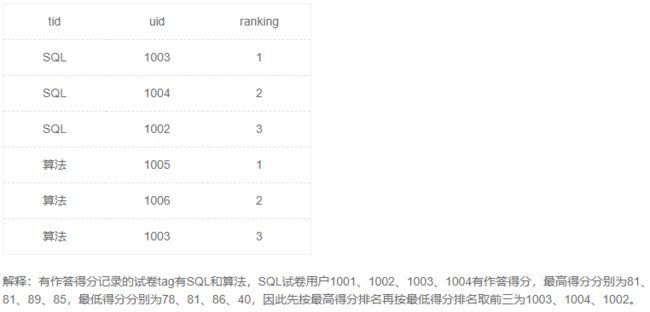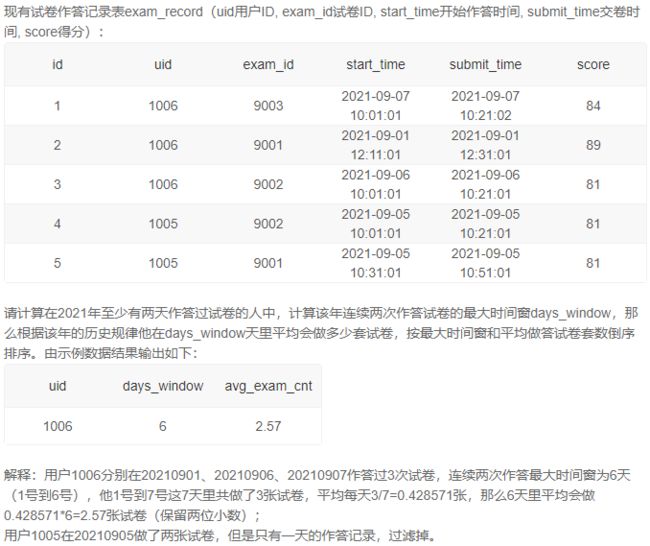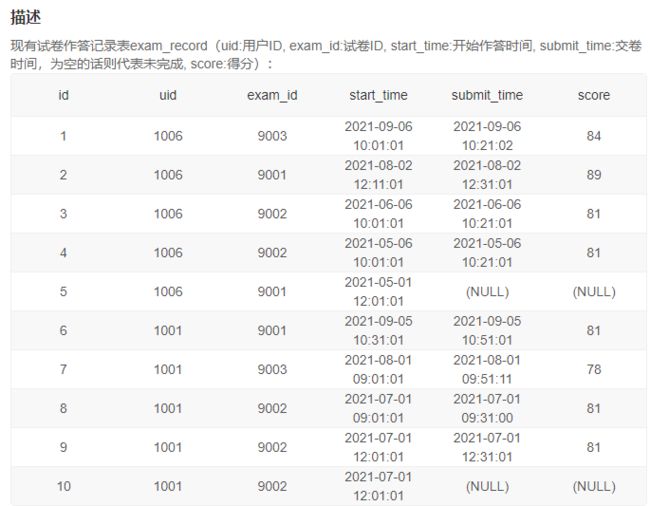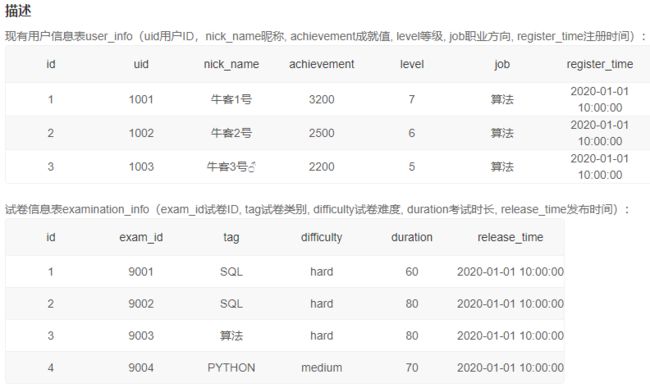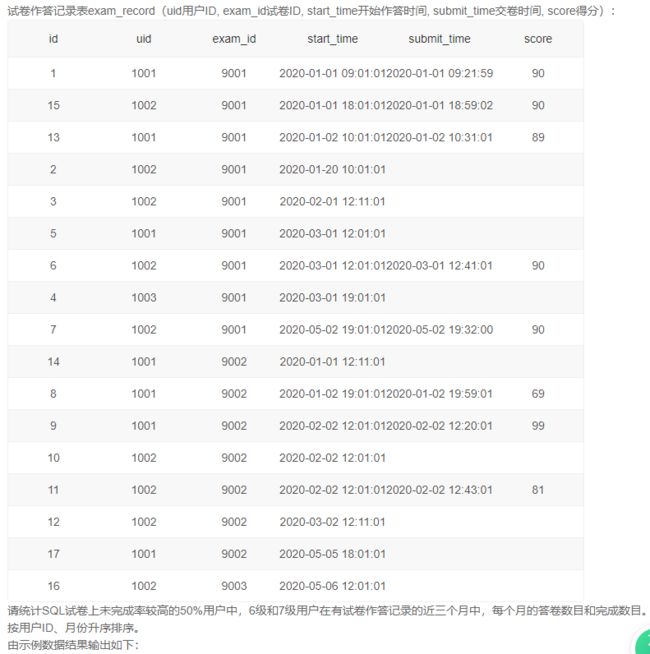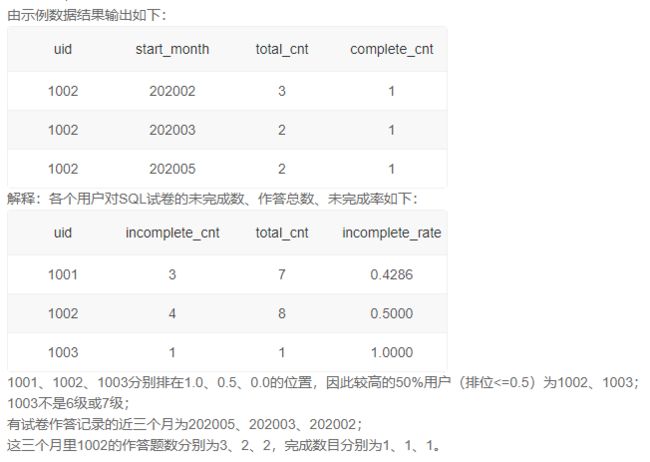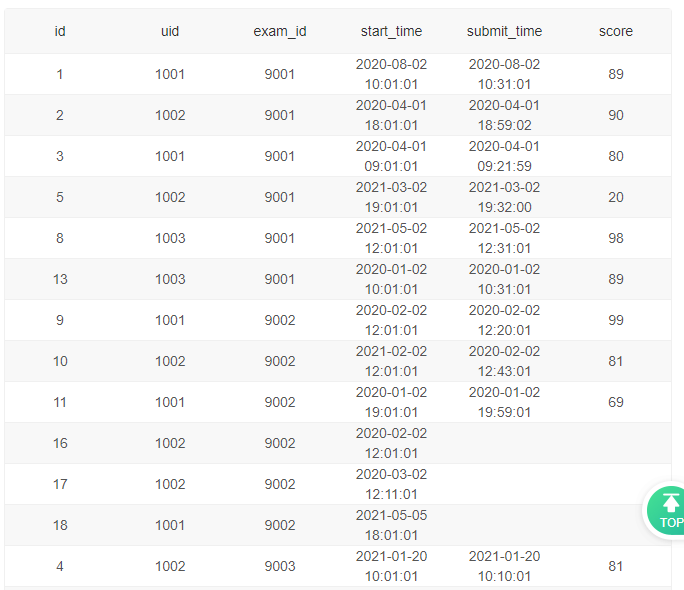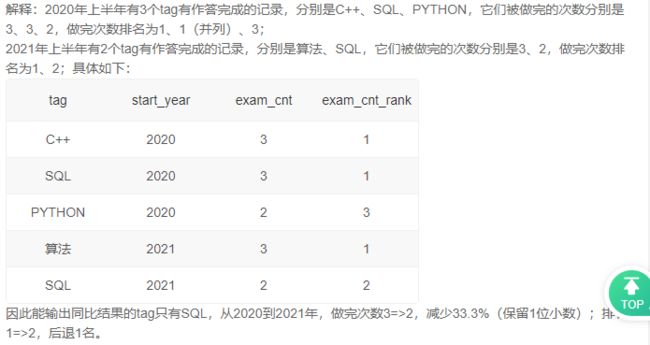〇、概述
一、专用窗口函数
1、每类试卷得分前3名
自己写出来的部分
SELECT
tag AS tid,
uid AS uid,
Rank AS ranking -- 如何确定排名
FROM examination_info ei
JOIN exam_record er
USING(exam_id)
GROUP BY tid
ORDER BY MIN(score) DESC,uid ASC
答案:
select u.tag tid,u.uid,u.ranking FROM
(SELECT *,
row_number() over (partition by t.tag order by t.max_score desc,t.min_score desc,t.uid desc) ranking
FROM
(SELECT i.tag,r.uid,max(r.score) max_score,min(r.score) min_score
from examination_info i
join exam_record r
on i.exam_id=r.exam_id
where r.score is not null
group by i.tag,r.uid
) t
) u
WHERE u.ranking<=3
或
SELECT tag,uid,ranking
FROM(
SELECT
tag,
uid,
row_number() OVER (PARTITION BY tag
ORDER BY tag, MAX(score) DESC, MIN(score) DESC, uid DESC)
AS ranking
FROM exam_record
JOIN examination_info USING(exam_id)
GROUP BY tag,uid
) new_examrecord
WHERE ranking < 4
学到:ROW_NUMBER() OVER( PATITION BY A ORDER BYB)
2、第二快/慢用时之差大于试卷时长一半的试卷
自己的想法
-- 查到快慢试卷
SELECT
er.exam_id,
-- ROW_NUMBER() OVER(PARTITION BY exam_id ORDER BY exam_id DESC)
-- 查询最大最小值
NTH_VALUE(time_took, 2) OVER (PARTITION BY exam_id ORDER BY time_took DESC) as max2_time_took,
FROM exam_record er
JOIN examination_info ei
USING(exam_id)
-- 从上表中查询第二快和第二慢的试卷时间之差
-- 从上表中选出时间之差小于dur/2的试卷id
答案:
选择出所有的时间(秒/60)
选择出满足条件的时间
选择出最终结果并排序
-- 步骤:先拼接,后选条件,最后选结果,每一步都要得到相应的数据
-- 最后选出符合条件的数据
-- 存在重复的现象
SELECT
exam_id,
duration,
release_time
FROM (
-- 再选出第二快和第二慢的试卷信息
SELECT
DISTINCT exam_id,
duration,
release_time,
NTH_VALUE(use_time,2) OVER(PARTITION BY exam_id ORDER BY use_time ASC) AS min_use_time,
NTH_VALUE(use_time,2) OVER(PARTITION BY exam_id ORDER BY use_time DESC) AS max_use_time
FROM (
-- 先两表join选出所有时间
SELECT
er.exam_id,
duration,
release_time,
TIMESTAMPDIFF(SECOND,start_time,submit_time)/60 AS use_time
FROM exam_record er
JOIN examination_info ei
USING(exam_id)
WHERE submit_time IS NOT NULL
) a
) b
WHERE
max_use_time IS NOT NULL
AND
min_use_time IS NOT NULL
AND
(max_use_time-min_use_time)>duration/2
ORDER BY exam_id DESC
3、连续两次作答试卷的最大时间窗
自己的想法
-- 在一张表中查询数据
-- 查询2021年至少有两天作答过试卷的人
-- 查询该年连续两次作答试卷的最大时间窗days_window
SELECT
uid,
days_window,
avg_exam_cnt
FROM (
)
做法1:【学习with a as(),b as ()】
LAG和LEAD
-- 在一张表中查询数据
-- 查询该年连续两次作答试卷的最大时间窗days_window
with a as
( -- 查询2021年至少有两天作答过试卷的人
select uid
from exam_record
where year(submit_time) = 2021
group by 1
having count(distinct date(start_time)) >= 2
)
,b as
(
-- 取相关数据,具体到2021年的天(且至少两次作答)
select er.uid,er.exam_id,date(er.start_time) as day
from exam_record er
join a on er.uid = a.uid
where year(start_time) = 2021
)
,c as
(
-- 求窗口期
select uid,
datediff(day,lag(day,1) over(partition by uid order by day asc))+1 as days_window
from (select uid,day from b group by 1,2) t
)
,d as
(
-- 求平均
select uid,count(*)/(datediff(max(day),min(day))+1) as avg_exam
from b
group by 1
)
-- 结果 注意:前面都要用start_time作为做题日期,而不是submit_time,否则会报错
select c.uid,max(c.days_window),round(max(c.days_window)*d.avg_exam,2) as avg_exam_cnt
from c join d on c.uid=d.uid
group by 1
order by 2 desc,3 desc
方案2:
SELECT uid, days_window, round(days_window*exam_cnt/diff_days, 2) as avg_exam_cnt
FROM (
-- 2.查询出days_window两次作答的最大时间窗以及相差的最大天数
SELECT uid,
count(start_time) as exam_cnt, -- 此人作答的总试卷数
DATEDIFF(max(start_time), min(start_time))+1 as diff_days, -- 最早一次作答和最晚一次作答的相差天数
max(DATEDIFF(next_start_time, start_time))+1 as days_window -- 两次作答的最大时间窗
FROM (
-- 1.通过LEAD查询出下一次作答的时间,并得到新的属性【窗口函数、uid分区】
SELECT uid, exam_id, start_time,
lead(start_time) over(partition by uid ORDER BY start_time) as next_start_time -- LEAD函数可以将连续的下次作答时间拼上
FROM exam_record
WHERE year(start_time)=2021
) as t_exam_record_lead
GROUP BY uid
) as t_exam_record_stat
WHERE diff_days>1
ORDER BY days_window DESC, avg_exam_cnt DESC
自己写出来的
-- 3、查询出最终结果
SELECT
uid,
days_window,
ROUND(num*days_window/min_max,2) AS avg_exam_cnt
FROM (
-- 2.查询出days_window两次作答的最大时间窗以及相差的最大天数
SELECT
uid,
COUNT(start_time) AS num,
DATEDIFF(MAX(start_time),MIN(start_time))+1 AS min_max, -- 最早最晚的时间差7
MAX(DATEDIFF(next_start_time,start_time))+1 AS days_window -- 最大时间窗6【大,小】
FROM (
-- 1.通过LEAD查询出下一次作答的时间,并得到新的属性【窗口函数、uid分区】
SELECT
uid,
exam_id,
start_time,
LEAD(start_time) OVER(PARTITION BY uid ORDER BY start_time ASC) AS next_start_time
FROM exam_record er
WHERE YEAR(start_time)=2021
) a
GROUP BY uid
) b
WHERE days_window>1
ORDER BY days_window DESC,avg_exam_cnt DESC
4、近三个月未完成试卷数为0的用户完成情况
思路:
-- 找每个用户的试卷作答完成数
-- 找每个用户近三个有作答记录的月份,
-- 没有试卷是未完成状态的用户【所有试卷都完成count(a)=count(b)】
答案:dense_rank()进行排序
方式:先按日期排好序得到序号,再找前三个记录并查出来,再分组,找到全部完成的用户情况,通过聚合函数计算
-- 3.分组选出全部都完成的完成数
SELECT
uid,
COUNT(start_time) AS exam_complete_cnt
FROM (
-- 2.选出近三条
SELECT
uid,
start_time,
submit_time
FROM (
-- 1.查询用户排序的作答记录
SELECT
uid,
start_time,
submit_time,
DENSE_RANK() OVER(PARTITION BY uid ORDER BY DATE_FORMAT(start_time,'%Y-%m') DESC) AS ranking
FROM exam_record er
) a
where ranking<=3
) b
GROUP BY uid
HAVING COUNT(start_time)=COUNT(submit_time)
ORDER BY exam_complete_cnt DESC,uid DESC
5、未完成率较高的50%用户近三个月答卷情况
思路:
-- 0.分组统计每个用户的未完成数目和总作答数目group by
-- 1.统计SQL试卷的未完成率排名(前50%)
-- 2.统计有作答记录的近三个月信息【日期排序,近三个月】
-- 3.统计六级和七级用户和每个月的信息
答案:
select uid,
date_format(start_time, '%Y%m') as start_month,
count(start_time) as tatol_cnt,
count(score) as complete_cnt
from(
select uid, start_time, score,
dense_rank() over(partition by uid order by date_format(start_time, '%Y%m') desc) as recent_months
from exam_record
) recent_table
where recent_months <= 3
and uid in(
select incomplete_rate_table.uid
from(
select uid,
row_number() over(order by (incomplete_cnt / total_cnt) desc, uid desc) as incomplete_rank
from(
select uid,
sum(if(score is null, 1, 0)) as incomplete_cnt,
count(start_time) as total_cnt
from exam_record
group by uid
) incomplete_cnt_table
) incomplete_rate_table join(
select count(distinct uid) as total_user
from exam_record
) t_u
join user_info
on incomplete_rate_table.uid = user_info.uid
where level >= 6
and incomplete_rank <= ceiling(total_user / 2)
)
group by uid, start_month
order by uid

